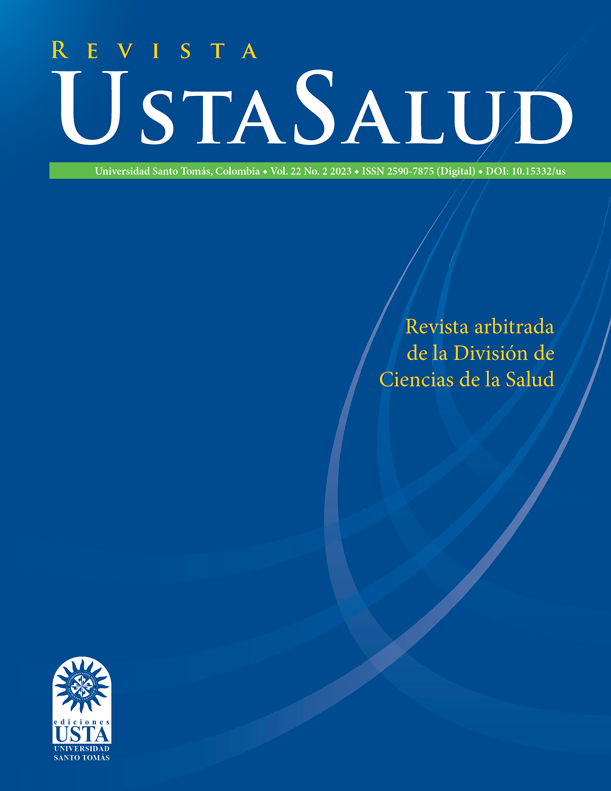Adherencia a medidas de prevención de contagio por Sars-Cov2 en universitarios
Resumen
Objetivo: Establecer los principales comportamientos y características que afectaron la adherencia a las medidas establecidas para reducir el impacto del Covid-19.
Materiales y Métodos: En un estudio observacional analítico de corte transversal, se evaluaron 530 estudiantes universitarios de diferentes universidades de Bucaramanga y su área metropolitana, mediante un muestreo por bola de nieve. Se evaluaron variables sociodemográficas y el cuestionario de adherencia diseñado y validado que incluye 13 preguntas (suma máximo 39 y mínimo 0 con opciones de respuesta en escala de likert de 4 opciones) y 3 preguntas sobre el tapabocas. El punto de corte de buena adherencia fue la media más una desviación estándar, (30 puntos). La investigación es clasificada como sin riesgo según la Resolución 008430. Los datos fueron analizados con regresión lineal en STATA 14
Resultados: Entre los evaluados el 64,5% fueron mujeres, el 83,3% estudiaban en universidad privada y el promedio de edad fue 20,7 con DE 4,0. Se evidencia cumplimiento de las principales medidas efectivas para el control de la trasmisión del virus SARS-Cov2. Sin embargo, un pequeño porcentaje, nunca las aplicó. Las mujeres tienen mayor adherencia a las medidas. Se observa el R2 0,035 y P=0,0008. Donde ser mujer implica 1,8 puntos más en puntaje de adherencia. El promedio del cuestionario de adherencia fue de 24,96 con DE 5,36 puntos y hay una correlación negativa -0,0489 entre edad y puntaje.
Conclusiones: Ser mujer y asistir a una facultad de salud en universidad privada implica mayor adherencia a las medidas.
Referencias
2. Wang TT, Moon HS, Le A, Carrasco LR, Panchal N. Proceedings from the OMS Resurgence Conference for resuming clinical practice after COVID-19 in the USA. Int J Oral Maxillofac Surg. 2020;49(12):1655-9. DOI: https://doi.org/10.1016/j.ijom.2020.09.014
3. Block R, Jr., Berg A, Lennon RP, Miller EL, Nunez-Smith M. African American Adherence to COVID-19 Public Health Recommendations. Health Lit Res Pract. 2020;4(3):e166-e70. DOI: https://doi.org/10.3928/24748307-20200707-01
4. Ministerio de Salud de la República de Colombia. Resolución 8430 de 1993: Por la cual se establecen las normas científicas, técnicas y administrativas para la investigación en salud. Bogotá: Ministerio de Salud; 1993.
5. Steens A, Freiesleben de Blasio B, Veneti L, Gimma A, Edmunds WJ, Van Zandvoort K, et al. Poor self-reported adherence to COVID-19-related quarantine/isolation requests, Norway, April to July 2020. Euro Surveill. 2020;25(37). DOI: https://doi.org/10.2807/1560-7917.ES.2020.25.37.20016075
6. Romero-Saritama, José Miguel, Simaluiza, Janneth, & Fernandez, Heriberto. Medidas de prevención para evitar el contagio por la COVID-19: de lo cotidiano a lo técnico-científico. Revista Española de Salud Pública. 2021; 95, e202104051. URL: http://scielo.isciii.es/scielo.php?script=sci_arttext&pid=S1135-57272021000100188&lng=es&tlng=es.
7. Al-Hasan A, Khuntia J, Yim D. Threat, Coping, and Social Distance Adherence During COVID-19: Cross-Continental Comparison Using an Online Cross-Sectional Survey. J Med Internet Res. 2020;22(11):e23019. DOI: https://doi.org/10.2196/23019
8. García-Alamino J. M. Aspectos epidemiológicos, clínica y mecanismos de control de la pandemia por SARS-CoV-2: situación en España [Epidemiological aspects, clinic and control mechanisms of SARS-CoV-2 pandemic: Situation in Spain]. Enfermeria clinica (English Edition). 2021; 31, S4–S11. DOI: https://doi.org/10.1016/j.enfcli.2020.05.001
9. Johnson AA, Wallace BK, Xu Q, Chihuri S, Hoven CW, Susser ES, et al. Hopelessness in New York State Physicians During the First Wave of the COVID-19 Outbreak. J Neurosurg Anesthesiol. 2022;34(1):152-7. DOI: https://doi.org/10.1097/ANA.0000000000000808
10. Ahmed MA, Jouhar R, Ahmed N, Adnan S, Aftab M, Zafar MS, et al. Fear and Practice Modifications among Dentists to Combat Novel Coronavirus Disease (COVID-19) Outbreak. Int J Environ Res Public Health. 2020;17(8). DOI: https://doi.org/10.3390/ijerph17082821
11. Domínguez, R., Zelaya, S., Gutiérrez, M., & Castellanos, E. Medidas de protección en personal de salud para disminución de riesgo de contagio de COVID-19. Ecuador: Instituto Nacional de Salud. 2020. 16 p. URL: https://docs.bvsalud.org/biblioref/2020/08/1087768/medidas-de-proteccion-de-bioseguridad-p-de-salud-17ago20.pdf
12. Zangoue M, Safari H, Royce SG, Zangooie A, Rezapour H, Zangouei A, et al. The high level of adherence to personal protective equipment in health care workers efficiently protects them from COVID-19 infection. Work. 2021;69(4):1191-6. DOI: https://doi.org/10.3233/WOR-210634
13. Barahmand U, Mohamadpour S, Sheikh Ahmad RH. COVID-19 Related Stresses, Conspiracy Beliefs, Uncertainty, and Non-adherence to Safety Guidelines. Int J Psychol Res (Medellin). 2023;15(2):22-33. Published 2023 Mar 1. DOI: https://doi.org/10.21500/20112084.5367
14. Hoyos-Hernández, Paula Andrea, Concha Valderrama, Vanessa, Valderrama Orbegozo, Laura Juliana, Díaz Mutis, Juan David y Tovar Cuevas, José Rafael. Adherencia a las conductas preventivas de la COVID-19 en mujeres trans colombianas. Revista Latinoamericana de Psicología. 2021; 53, 190-199. DOI: https://doi.org/10.14349/rlp.2021.v53.21
15. Chen SC, Hong Nguyen NT, Lin CY, et al. Digital health literacy and well-being among university students: Mediating roles of fear of COVID-19, information satisfaction, and internet information search. Digit Health. 2023;9:20552076231165970. Published 2023 Mar 27. DOI: https://doi.org/10.1177/20552076231165970















